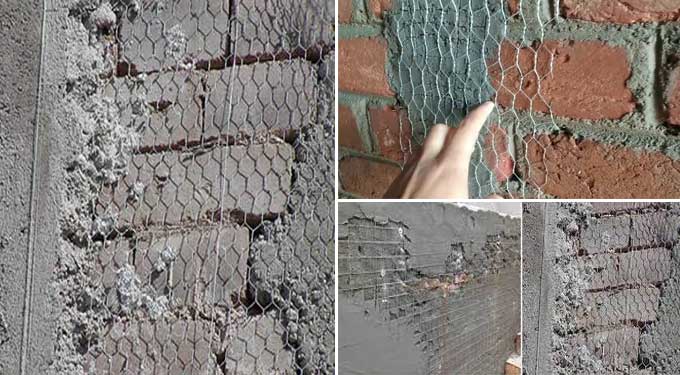
Everything you need to know about Chicken Mesh for Construction
In construction, the chicken mesh is a type of wire mesh that is used as a reinforcing material for plaster or stucco walls. It is made of galvanized steel wire that is woven into a grid pattern with small openings, similar to the type of chicken mesh used in poultry farming.
Chicken mesh is typically attached to the surface of a wall, and then a layer of plaster or stucco is applied on top of it. The mesh helps to hold the plaster or stucco in place and prevents it from cracking or falling off over time. The mesh also adds strength and durability to the wall, making it more resistant to impacts and weathering.
Chicken mesh is commonly used in construction for both interior and exterior walls, as well as for ceilings and other surfaces that require reinforcement. It is an affordable and easy-to-install material that can help to improve the longevity and performance of a building's walls and surfaces.
What are the different types of Chicken Mesh used in Construction?
Chicken mesh, also known as poultry netting or wire netting, is a type of wire mesh that is commonly used in construction for various purposes such as reinforcing concrete, plastering walls, and fencing. There are different types of chicken mesh available, and their selection depends on the specific construction application.
Here are some of the most commonly used types of chicken mesh in construction:
- Galvanized Chicken Mesh: This type of mesh is made of galvanized steel wire, which is coated with a layer of zinc to prevent corrosion. Galvanized chicken mesh is ideal for outdoor applications and can withstand harsh weather conditions.
- PVC Coated Chicken Mesh: This type of mesh is made of galvanized steel wire that is coated with PVC to provide added protection against corrosion and rust. It is commonly used for fencing and can also be used for decorative purposes.
- Stainless Steel Chicken Mesh: This type of mesh is made of stainless steel wire, which is highly resistant to corrosion and rust. It is ideal for use in harsh environments such as marine applications and is commonly used in construction for reinforcing concrete.
- Hexagonal Chicken Mesh: This type of mesh has a hexagonal shape and is commonly used for fencing and protecting plants from animals. It is made of galvanized steel wire and is available in different mesh sizes.
- Welded Chicken Mesh: This type of mesh is made by welding wires together to form a square or rectangular pattern. Welded chicken mesh is commonly used for reinforcing concrete, plastering walls, and for fencing.
- Knitted Chicken Mesh: This type of mesh is made of knitted wire and is commonly used for decorative purposes such as garden fencing or for protecting small animals like rabbits or birds.
It is important to select the right type of chicken mesh based on the specific requirements of the construction application to ensure optimal performance and longevity.
What are some Advantages of Using Chicken Mesh in the field of construction?
Here are some of the advantages of using chicken mesh in construction:
- Durability: The chicken mesh is made of strong and durable wire, which makes it resistant to wear and tear. This makes it an ideal choice for use in construction where strength and durability are important.
- Versatility: Construction projects can utilize chicken mesh in a variety of ways. It can be used as reinforcement in concrete, as a protective barrier for windows, as a fencing material, and more.
- Cost-effective: Chicken mesh is relatively inexpensive compared to other construction materials, which makes it a cost-effective option for builders and contractors.
- Easy to install: Chicken mesh is easy to cut and shape, which makes it easy to install. It can be easily attached to frames or structures using staples or other fasteners.
- Corrosion-resistant: The chicken mesh is typically made of galvanized steel, which makes it resistant to corrosion. This means that it can be used in outdoor applications without worrying about rust or degradation.
The versatility and cost-effectiveness of chicken mesh make it a popular choice among contractors and builders.
How to install a chicken mesh?
Installing construction chicken mesh involves the following steps:
- Measure the area: Measure the area where you want to install the chicken mesh to determine the amount of material you will need.
- Gather materials: Purchase the necessary materials, including the chicken mesh, U-shaped nails or staples, and pliers or a hammer.
- Prepare the surface: Clear the area of any debris or obstacles that may impede the installation process.
- Cut the chicken mesh: Cut the chicken mesh to fit the area you want to cover. Use pliers or wire cutters to cut the mesh.
- Attach the chicken mesh: Secure the chicken mesh to the surface using U-shaped nails or staples. Make sure to start at one corner and work your way across the area, pulling the mesh taut as you go.
- Trim the excess mesh: Trim any excess mesh using pliers or wire cutters.
- Secure any loose ends: Use pliers to secure any loose ends of the mesh to prevent it from snagging on anything.
- Inspect the installation: Inspect the installation to ensure that the mesh is securely attached and free from any defects or irregularities.
To get more details, watch the following video tutorial.
Video Source: Civil Site visit
Remember to wear appropriate safety gear, such as gloves and eye protection, while installing the chicken mesh.


